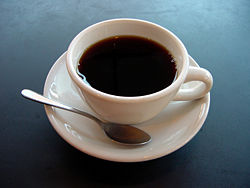Coffee
Regardless of its preparation, coffee is one of the most popular and widely consumed beverages in the world today. It is well-known to contain the stimulant caffeine as well as antioxidants and other plant chemicals (phytochemicals). Coffee is typically brewed from roasted beans (actually seeds) harvested from cherries grown from the genus of plants known as Coffea. There are six species of tropical Coffea trees[1], of which there are as many as 6,000 known varieties.
The outer skin of the coffee cherry is the exocarp; beneath it is a thin layer of pulp known as the mesocarp, then a slimy layer called parenchyma. The beans within the parenchyma are covered in the thin layer referred to as the endocarp. Inside the endocarp are two beans, usually positioned next to each other, divided by a membrane called the spermoderm.
Although the availability of coffee is almost ubiquitous, Coffea trees can only be grown in certain climates. The most effective places to grow coffee are in tropical or sub-tropical environments at high altitudes. Because of this, distinct places in the world are prime for Coffea cultivation: Brazil, Colombia, India, Indonesia, Mexico, Puerto Rico, and Vietnam are the top Coffea growing and exporting countries.
Coffee can be prepared and served in a number of ways. A common Western method calls for roasted beans to be ground (coarse) and then placed into a paper filter, where hot water is then strained into the filter, soaking the grounds, from which the coffee drips into a coffee pot. The appliances that produce coffee in this way are known as drip-style coffee makers, or "drip-pots" in the USA, and as coffee filter machines in Europe.
Greek, Turkish and other coffees from the Ottoman period are made by rapidly boiling finely-ground roasted beans, along with the appropriate amount of sugar, in a special small metal pan. The resulting mix is poured into a small cup, of which only the upper liquid is drunk. The bottom third or so of the cup contains coffee grounds.
A popular, originally Italian, method of preparing coffee is to finely grind heavily roasted beans and compress them into a metal filter. Hot water is then forced through the filter, producing a concentrated form of coffee that is very dark in color and contains a higher percentage of caffeine per milliliter compared to other forms. This is known simply as espresso and is often served in quantities of ounces, or "shots." Espresso machines can create pressure by either heating water up to its boiling point, creating steam to produce the concentrate, or through a pump that injects water into the compressed grounds. The amount of compression (measured in pounds/square inch (psi)) varies between the different styles of appliances.
Caffeine and the development of decaffeinated coffee in the West
Although there are naturally occurring differences in the caffeine content and antioxidative properties of Coffea plants, there remains a commercial demand for decaffeinated coffee, which must be chemically treated in order to remove 97% of the caffeine present in the beans. The two most common types of beans sold world-wide, Arabica (Coffea arabica) and Robusta (Coffea robusta), do contain different levels of alkaloid caffeine, the latter typically having more than the former. However, "decaf" (as its commonly referred to) is produced by one of two post-harvest methods. In the first, known as indirect, the beans are soaked in hot water to dissolve the caffeine. The water is then treated with a chemical solvent to remove the caffeine. In order to maintain the taste or flavour constituents, the water is resprayed back into the beans. The direct method involves soaking the beans in the chemically treated water, removing the solvent from the water, and then allowing the beans to resoak.
There are four different chemical processes by which coffee can be decaffeinated[2]:
- Methylene chloride (DCM): DCM is involved in the direct method of decaffeination. The disadvantages to using DCM are that it is a carcinogenic, and an ozone-depleting gas.
- Ethyl Acetate: Ethyl acetate exists in fruit naturally, but for commercial decaffeination it is produced from ethyl alcohol and acetic acid. The resulting product can be carcinogenic.
- Supercritical Carbon Dioxide: the raw coffee beans are exposed to pressurized, liquid carbon dioxide. In an evaporator, the caffeine is drawn out by the carbon dioxide and precipitates; after a period of evaporation and recondensation, the mixture is recirculated into the coffee.
- Swiss Water Process: Devised by Kraft Foods Inc, this is a chemical free process. Beans are first soaked in water, which absorbs the caffeine content. The water is passed through carbon filters which process out the caffeine. A fresh batch of beans is then soaked in the caffeine-free water, which still retains much of the flavour constituents from the previous soak.
Coffee, caffeine, and health
Coffee contains caffeine, antioxidants, and other plant chemicals, all of which may affect disease risks. Although nutritionists, researchers, and consumers are aware that coffee contains potentially beneficial compounds, the precise effects of these compounds are not always well understood and may not affect everyone equally. Among habitual and moderate coffee drinkers (individuals who consume 2-3 cups per day), the risk of developing Alzheimer’s and other neurodegenerative diseases may be significantly lower than in non-coffee drinkers. Yet, some compounds found in coffee may be harmful or unsuitable for certain individuals, including pregnant women, epilepsy patients, and those with, or at risk for, osteoporosis. Moreover, how coffee is prepared can influence how beneficial or harmful it is for one's health. Current knowledge of the effects of coffee consumption on cardiovascular disease, physical fitness, brain function, reproduction, bone and joint health, type 2 diabetes and weight loss, and the digestive system comes from many and varied sources, but some main points and recent findings have been outlined below.
At present, no clear causal relationship has yet been found between cardiovascular disease (CVD) and coffee consumption. Although results of scientific studies have been contradictory or inconclusive, there are some possible links between coffee consumption and the risk for CVD: for example, coffee prepared without a filter contains compounds known to raise low density lipoprotein levels. Additional risk factors, such as smoking, may also confound the relationship between coffee consumption and CVD. Nevertheless, most current studies suggest that habitual and moderate consumption of filtered coffee does not increase CVD risk.
Many studies have indicated that low to moderate doses of caffeine may have ergogenic (beneficial) effects on physical fitness. Caffeine in low doses increases exercise tolerance, reduces muscle pain during exercise, improves respiratory efficiency, delays fatigue, and increases endurance. Despite the documented benefits of caffeine, however, caffeinated coffee is commonly considered to be a mild diuretic, although recent studies have found that this is not the case.
Coffee consumption has been associated with various aspects of mental health and brain function, including lowered risks for neurodegenerative diseases. Coffee is well-known for its positive effects on mental alertness and psychological left, benefits often attributed to caffeine content. Among habitual drinkers, even heavy intake does not seem to be associated with decreased sleep duration. Overall, current scientific literature suggests that coffee and caffeine are more likely to enhance rather than impede mental function. Recent epidemiological studies suggest that habitual coffee drinking may help delay the onset of Alzheimer's disease. Regular and moderate caffeine use has also been associated with a lower incidence of Parkinson's disease.
Because caffeine interferes with reproduction among females, pregnant women are commonly advised by family, friends, and physicians to avoid drinking regular coffee during pregnancy. Studies conducted over the past few years indicate a possible association between caffeine and reduced fetal viability, but this relationship is not well understood and results have often been contradictory. While some studies seem to suggest that caffeine intake increases the risk for spontaneous abortion, other studies find no such link. Moderate coffee drinking may be non-harmful and possibly even beneficial during later stages of pregnancy, but heavy coffee drinking is not recommended among pregnant women in their first or second trimesters.
Earlier studies indicated that heavy coffee drinkers might be at greater risk for diseases that affect 'bone and joint health, including risk for rheumatoid arthritis and osteoporosis. Although the former concern now appears unsubstantiated, recent studies have confirmed a relationship between caffeine intake and calcium imbalance, especially in post-menopausal women. Moderate coffee intake (one or two cups per day) does not appear to significantly impact calcium balance, but amounts greater than two cups per day may increase one's risk for reduced bone mineral density later in life. Drinking a glass of milk per day may offset this risk, however.
Type 2 diabetes and weight loss are of great concern in the United States, where obesity and type 2 diabetes are common. The most current research suggests that regular, moderate coffee drinking may help decrease the risk for these epidemic diseases. Chlorogenic acid, an antioxidant present in coffee, may be responsible for a lowered risk for type 2 diabetes among habitual coffee drinkers, but more research is needed before the relationship between diabetes, weight loss, coffee, and caffeine can be clarified.
Several studies over the past decade have related coffee consumption with lowered risks for diseases involving the digestive system, including symptomatic gallstone disease, colorectal cancers, and chronic liver disease.
Overall, and as with many substances, coffee drinking seems to be a non-harmful habit for individuals who drink it regularly and in moderation, and in fact, it may even be beneficial for most people. Not all preparation methods are alike, however, and there is strong evidence that filtered coffee is a much healthier alternative to boiled or French-pressed coffee. There is little evidence to suggest that the caffeine present in coffee is unhealthy for most individuals, although it is a stimulant and should not be consumed in large quantities. Caffeine may actually be an ergogenic aid, for both mental alertness and physical fitness, when consumed in moderation. It should be noted that regardless of preparation and whether or not it contains caffeine, coffee is a good source of antioxidants.
References
- ↑ PLANTS Profile for Coffea (Coffee) - USDA PLANTS. United States Department of Agriculture. Retrieved on 2007-08-09.
- ↑ About Coffee, The Bean. Equator Coffee. Retrieved on 15-06-2007.

